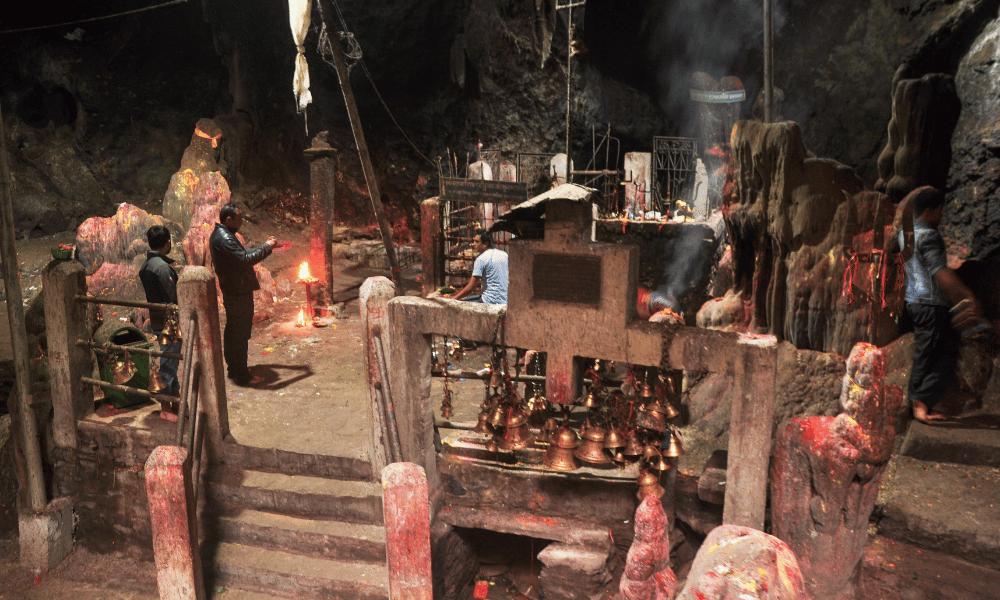Halesi Mahadev Temple, located in the district of Khotang in east Nepal hill, has a special place in the hearts of believers and explorers alike. When the two words Hari (Vishnu) and Isvara (Shiva) are joined, they form the word Haresvara, and the name Halesi results from the sounding word's distortion. This ancient temple, known as the "Pashupatinath of the East," encompasses centuries of devotion, mythical significance, and awe-inspiring natural beauty. Halesi Mahadev is a holy pilgrimage site for Hindus, Buddhists, as well as for Kiratis. This sacred site is associated with Lord Shiva in Hinduism, Guru Padmasambhava in Buddhism, and Raichakule in the Kirat community.
The history of the temple is linked with Hindu mythology, as it is thought to be a sanctuary where Lord Shiva sought refuge from the demon Bhasmasura. Halesi Mahadev Temple, with its hidden caves and peaceful surrounding, emits a mystical energy that draws visitors in. The main cave, shaped like a cow's head, adds to the allure of the location. Pilgrims from all across Nepal and India go long distances to seek Lord Shiva's blessings in this esteemed spot.
Beyond its legendary roots, the Halesi Mahadev Temple represents Nepal's historical and cultural heritage. Its architecture and traditions reflect its unique blend of Hindu and Buddhist influences, highlighting the religious diversity that characterizes Nepal's cultural landscape. When visitors enter this sacred space, they are greeted with an environment that transcends time, a monument to the unwavering faith and deep spirituality that draws people to this sacred spot. In the heart of the stunning beauty of eastern Nepal, the Halesi Mahadev Temple invites all to explore its mysteries and embrace its spiritual significance.
Halesi Mahadev Temple Facts
|
Site |
Halesi Mahadev |
|
Affiliation |
|
|
Deity |
Lord Shiva |
|
Location |
Halesi, Khotang |
|
Established by |
N/A |
|
Major Attractions |
|
|
Major Celebrations |
|
|
Style |
|
|
Opening Hours (main temple) |
06:00 AM - 08:00 PM |
|
Entry Fee |
No Entry Fee |
History and Mythology
Halesi Mahadev Temple, nestled in the eastern hills of Nepal, holds a multifaceted origin and history that intertwines the beliefs of Buddhism, Hinduism, and the indigenous Kirat community. Each of them has its own interpretations of history and association with the Mahadeva of Halesi as discussed below:

Buddhist Perspective
In Buddhism, Halesi Mahadev Temple is known as the Maratika Cave or Maratika Monastery, and it is one of the most sacred sites associated with Vajrayana Buddhism's tantric rituals. It is thought to be the location where Guru Rinpoche (Padmasambhava), the founder of Tibetan Buddhism, and his spouse, Mandarava, gained immortality through long-life rituals and meditation.
According to Buddhist mythology, the Buddha Amitabha taught Guru Rinpoche and Mandarava about longevity and immortality. In the Halesi caves, Guru Rinpoche attained enlightenment and boundless life. Pilgrims from Tibetan Buddhism, in particular, visit Maratika Cave to seek blessings, meditate, and perform rituals linked with longevity and spiritual enlightenment.
Hindu Perspective
The Halesi Mahadev Temple is associated with Hinduism and is devoted to Lord Shiva. According to Hindu legend, Lord Shiva took refuge in the Halesi caves to flee the demon Bhasmasura. The caves are considered where he stayed during the escape, and pilgrims think that seeking his blessings at this sacred spot can offer protection, liberation, and the fulfillment of desires.
Halesi has become linked with the heavenly presence of Lord Shiva, attracting followers from all over Nepal and India. The mythological origins and architectural features of the temple show the region's substantial Hindu influence.
Kirat Perspective
One of Nepal's oldest ethnic groups, the indigenous Kirat people, has long-standing ties to the Halesi Mahadev Temple. Raechhakule (Khokchilipa), also known as Hetchhakuppa, is their ancestral deity, and according to their ancient beliefs, he resided in the sacred caves.
At Halesi, the Kirat community holds a number of rites and ceremonies to honor their deity and ask for protection, wealth, and well-being. The temple complex is a crucial component of Kirat spirituality and culture.
The religious and cultural diversity of Nepal is exemplified by the Halesi Mahadev Temple. It serves as a holy location that unites Kirat spirituality with Hinduism, Buddhism, and other faiths. Regardless of one's religion, the temple continues to draw followers and seekers from all backgrounds to its venerated caverns and sacred grounds because of its mystique and historical significance.
Cultural and Religious Significance
The Halesi Mahadev Temple, located in Nepal's eastern hills, is of immense cultural and religious significance that goes beyond boundaries and religions. From a cultural standpoint, the temple represents Nepal's rich heritage as a whole. It is evidence of the country's capacity to value and honor its diverse identity. The Halesi Mahadev Temple is a symbol of how peacefully these various traditions can coexist in a nation where there are many different ethnic groups and religions. At this holy location, pilgrims and visitors from all backgrounds come together, promoting the concepts of diversity and unity.
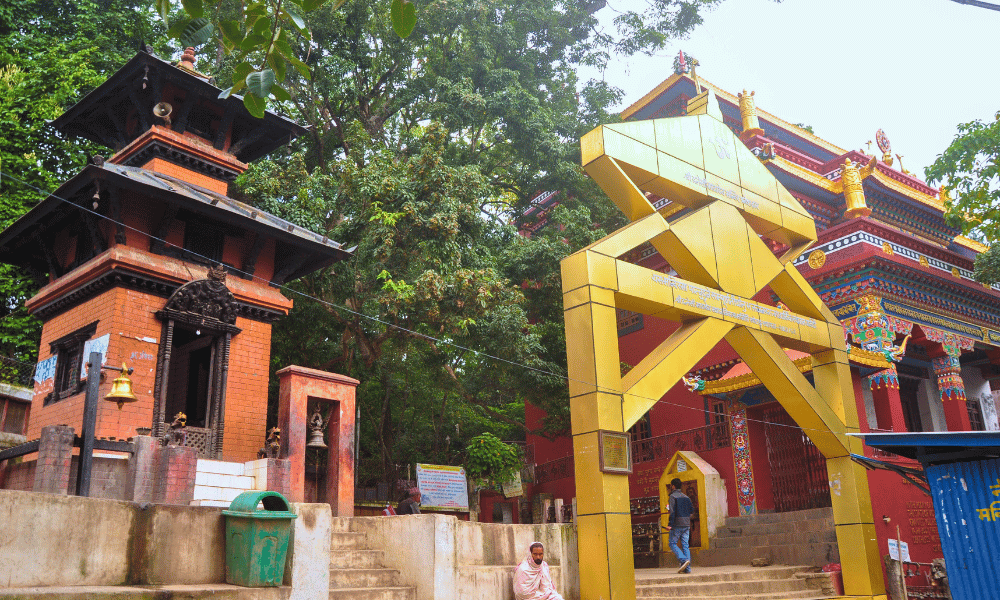
Halesi is known as the Maratika Cave in Vajrayana Buddhism and is linked to Mandarava and Guru Rinpoche (Padmasambhava). Buddhists go to the complex of temples to meditate, perform rituals, and pray for long life and enlightenment. It is regarded as one of the holiest tantric locations in Buddhism.
The indigenous Kirat people believe that Yuma Sammang, their ancestor god, resides in Halesi. At the temple, they engage in customary rites and ceremonies in an effort to obtain safety, wealth, and wellbeing. The temple represents the Kirat people's strong spiritual ties to their homeland and culture.
The Halesi Mahadev Temple also acts as a symbol of religious harmony, bringing together worshippers of all faiths to partake in the spiritual energy of the location. It serves as a representation of religious communities of all kinds showing tolerance, acceptance, and respect for one another.
Major Attractions
Halesi Mahadev Temple and its surrounding areas offer a wealth of attractions for visitors and pilgrims alike. Here are some of the major attractions and points of interest in and around the temple complex:
Halesi Mahadev Cave
A natural wonder, Halesi Mahadev Cave’s entrance is shaped like a cow’s head and enchants tourists with its unusual physical characteristics. The cave complex is made up of a number of magnificent limestone caves that are embellished with elaborate stone carvings near the entrance. The caves' interior features stunning geological formations, such as towering stalactites and stalagmites, which give the space a magical and otherworldly feel. The cave's central shrine houses a self-manifested stone lingam depicting Lord Shiva, flawlessly integrating natural beauties with architectural elements of devotion.
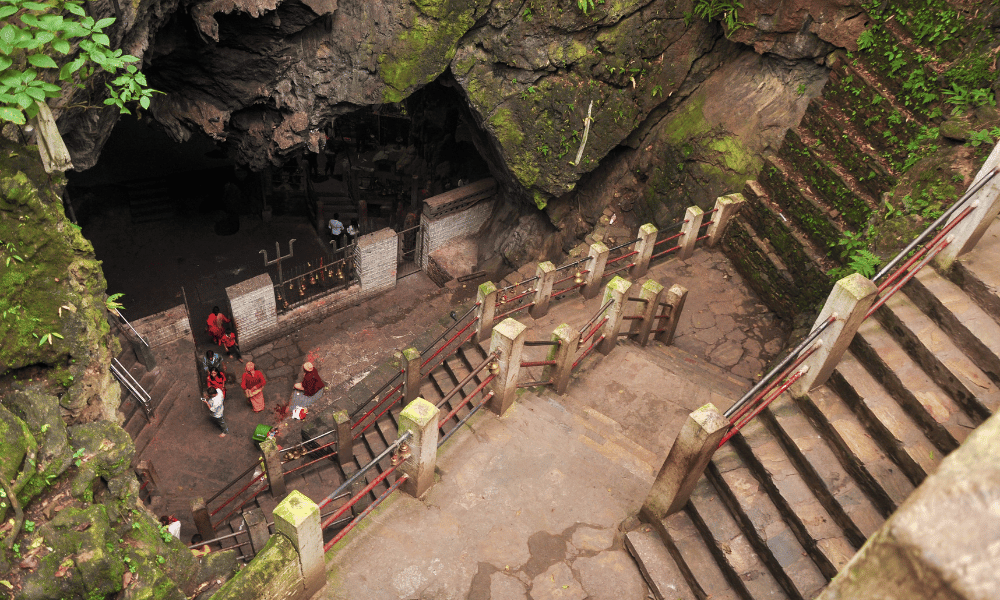
Halesi Mahadev Cave is rich in religious importance and attracts visitors from the Hindu, Buddhist, and Kirat traditions. It is considered one of Lord Shiva's holiest locations in Nepal by Hindus. According to legend, Lord Shiva took sanctuary in these caves to flee the demon Bhasmasur, thereby making them a representation of heavenly protection. With holy water, devotees bathe the self-manifested lingam, requesting blessings and divine favor.
Buddhists also hold Halesi Cave in high regard and relate it to the local deity "Karunamaya," also known as the bodhisattva Avalokiteshvara. Buddhists seeking spiritual enlightenment and peace frequently travel to the caves since they have served as refuge for meditating monks for ages. Halesi Cave has a multi-religious significance that makes it a symbol of religious harmony and unity in Nepal's diverse spiritual environment. Kiratis, an indigenous community, also regard the cave as sacred.
Basaha Cave
Within the Halesi Mahadev Cave complex, Basaha Cave is a hidden jewel that offers a unique fusion of geological marvels and immense religious importance. Despite being smaller than its twin, Halesi Mahadev Cave, this cave has a unique set of characteristics that entice both tourists and adventurers to enter its mystic embrace.

The Basaha Cave's entrance has naturally occurring stone themes and sculptures that feature a variety of gods and spiritual symbols and serve as a starting point for a spiritual journey. Visitors are welcomed inside by an exquisite display of stalactites and stalagmites that have been produced over generations and have created an otherworldly atmosphere. Basaha Cave is notable for its amazing natural "Sankha'' or conch shell shape, which is what makes it so unique. This amazing geological marvel adds a special dimension to the spiritual ambiance of the cave because it closely resembles the sacred conch shell adored in Buddhism and Hinduism.
The sacred bull Nandi and the serpent god Naga, both of which are strongly linked to Lord Shiva in Hindu mythology, are also represented inside the cave. Inside the cave, there is a big footprint dug on the wall ceiling which is believed to be of Shiva Mahadeva as he stepped on the wall before disappearing by making a hole in the roof of the cave with his trishul (trident). The cave also has symbols of Lord Ganesh, the elephant-headed deity, and Kartikeya (Kartik), both Lord Shiva's sons, highlighting its complex spiritual significance and link to the larger number of Hindu deities. In addition, representations of Lord Shiva's consort, Goddess Parvati, serve as a reminder of the power of the divine feminine. These symbols add to Basaha Cave's spiritual tapestry and provide visitors a more complete spiritual experience in this revered place.
Since Basaha Cave is devoted to Lord Shiva, Hindus place a great deal of religious significance on it. People who are deeply devoted to Lord Shiva gather here to give earnest prayers, light oil lamps, and carry out rituals. Many people consider the natural Sankha structure to be a divine symbol that captures the deity's presence in the cave. While meditating in the cave, pilgrims frequently find comfort and seek spiritual breakthroughs, with the conch-shaped stalactite acting as a sacred focal point.
5 Dwars
Within the sanctified Halesi Mahadev Temple, five distinctive gates or passages formed through the natural process of geological transformation, known as 'Dwars,' stand as spiritual portals. Each Dwars holds a unique name and meaning, inviting pilgrims to embark on a profound journey of devotion and enlightenment, where the earthly and the divine converge.
Swarga Dwar (Gate of Heaven): Swarga Dwar represents the beginning of a spiritual journey within the temple complex. Passing through this gate signifies the transition from the earthly realm to a more celestial and spiritual dimension. It symbolizes the commencement of a spiritual ascent toward higher states of consciousness and enlightenment.
Dharma Dwar (Gate of Righteousness): Dharma Dwar is the entrance associated with the concept of "dharma" or righteousness and duty. Passing through this gate signifies a commitment to leading a virtuous and righteous life in accordance with one's moral obligations and spiritual duties.
Paap Dwar (Gate of Sin): Paap Dwar symbolizes the abandonment of worldly sins and impurities before entering the temple. It represents the purification of one's soul and the relinquishment of sins, signifying a desire to approach the divine with a pure heart.
Janma Dwar (Gate of Birth): Janma Dwar represents the recognition of the cycle of birth and rebirth, known as samsara in Hinduism. Passing through this gate signifies an acknowledgment of the cycle of life and a desire to transcend it through spiritual practice and understanding.
Karma Dwar (Gate of Deeds): Karma Dwar, also known as "Kriya Dwar," signifies the importance of one's actions and deeds in the spiritual journey. It represents the idea that individuals are bound by their karma, the consequences of their actions, and that these actions shape their spiritual path.
These five Dwars collectively guide devotees on a profound spiritual journey within the Halesi Mahadev Temple. Each gate holds its unique symbolism, reminding visitors of various aspects of the human experience and the path to spiritual growth and enlightenment.
Major Festivals
The Halesi Mahadev Temple in Nepal observes several major festivals, attracting pilgrims and devotees from various regions. Some of the major festivals celebrated at this temple include:
Maha Shivaratri
At the Halesi Mahadev Temple in Nepal, Maha Shivaratri is a profoundly moving celebration of devotion to Lord Shiva. This major celebration normally takes place in February or March and attracts tens of thousands of pilgrims and followers from all over the world. This night has great spiritual importance since it represents the coming together of the divine and the human.
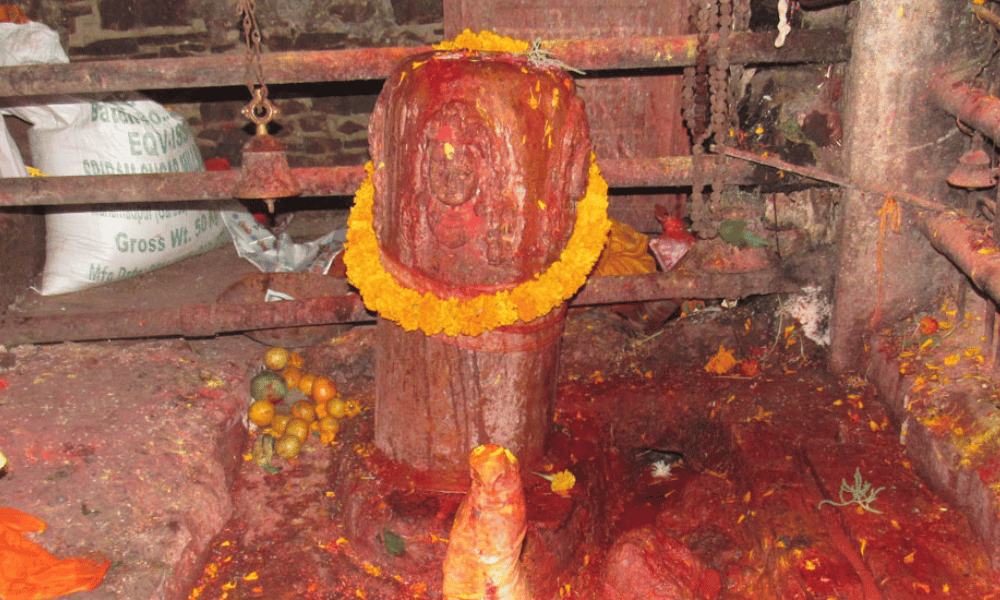
During Maha Shivaratri, the temple grounds are alive with a distinct feeling of devotion and spirituality. After making the difficult journey to the temple, pilgrims gather there and spend the entire night performing rituals, praying, and meditating. The sound of incense burning, the singing of sacred mantras, and the flickering of oil lights all contribute to the spiritual environment.
The sacred lingam (an abstract symbol of the deity) of Lord Shiva is presented with offerings from devotees such as flowers, milk, and bael leaves. On Maha Shivaratri, it is believed that worshiping Lord Shiva cleanses one of sins and bestows the blessings of strength, wisdom, and inner peace. The event honors Lord Shiva, but it also serves as a symbol of the unwavering devotion and passion of those who come to the Halesi Mahadev Temple to behold the heavenly blessings of Lord Shiva.
Learn More: Shivaratri Festival
Bala Chaturdashi
The Halesi Mahadev Temple in Nepal, particularly in the Khotang area where the temple is situated, celebrates Bala Chaturdashi as a significant festival. The Hindu lunar calendar places this event in the month of Kartik (October–November), and it is celebrated on the fourteenth day of the dark fortnight (Krishna Paksha).
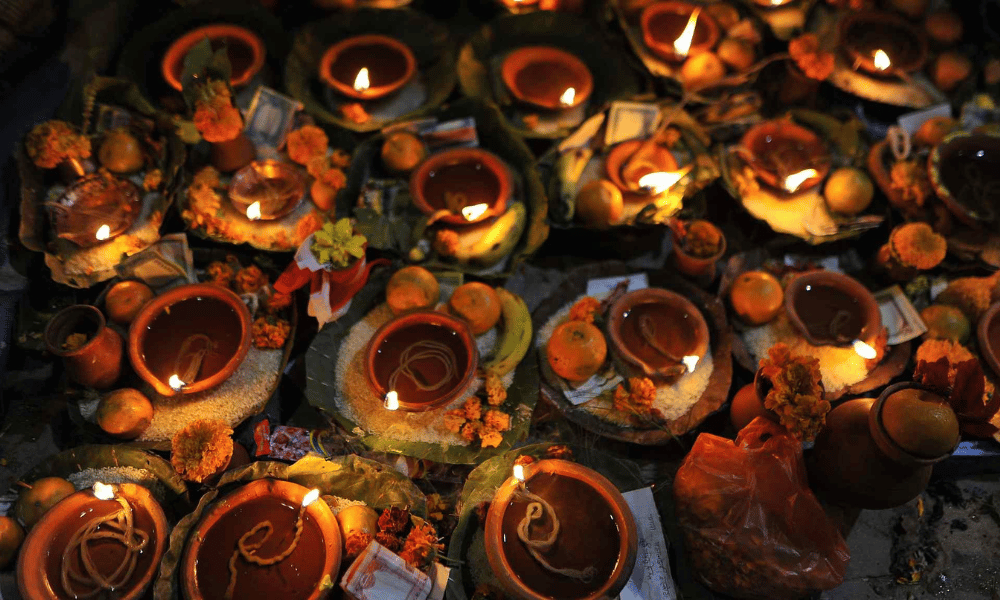
In this area, Bala Chaturdashi has particular religious and cultural significance. It is a day set aside for honoring departed ancestors and requesting their blessings and eternal peace for their souls. On this day, devotees engage in rituals and prayers in the hopes of assisting their deceased ancestors in achieving moksha (freedom from the cycle of rebirth).
Pilgrims visit the Halesi Mahadev Temple on Bala Chaturdashi to offer prayers and carry out religious rites. One of the well-known customs involves illuminating the road for the deceased loved ones' souls by lighting oil lamps, or diyas, on the temple grounds. To honor their ancestors, devotees also hold pujas (prayer ceremonies) and offer food, water, and other symbolic goods.
The celebration generates a sense of devotion and unity by bringing together families and communities. It's a moment when individuals may show their respect for the dead and deepen their spiritual ties. In addition to being a religious celebration, Bala Chaturdashi at the Halesi Mahadev Temple is also a cultural ritual that captures the deeply ingrained values and customs of the locals in Nepal.
Ram Navami
An important Hindu festival known as Ram Navami is observed at the Halesi Mahadev Temple in Nepal, which is devoted to Lord Shiva. Though Ram Navami is revered in this area on a religious and cultural level, Lord Shiva is the temple's primary deity.
Ram Navami, which commemorates the birth anniversary of Lord Rama, one of Lord Vishnu's avatars, usually occurs in the Hindu month of Chaitra (March–April). During this event, worshippers go to the Halesi Mahadev Temple to beg Lord Shiva's blessings and to honor Lord Rama.
The temple holds special prayers, bhajans (devotional songs), and religious ceremonies during Ram Navami. The epic tale of Lord Rama's life, the Ramayana, may also be read or recited by devotees. As a sign of devotion, offerings of flowers, fruits, and sweets are made to the gods. Devotees can express their devotion for Lord Rama and seek his blessings throughout the event. During this season, the temple complex comes alive with religious enthusiasm and cultural events, enhancing the region's diversity of religious practices.
Teej Festival
The Halesi Mahadev Temple in Nepal enthusiastically celebrates Teej, a colorful and major Hindu holiday. This festival is especially significant to married women who visit the temple to seek Lord Shiva and Goddess Parvati's blessings for marital bliss and the welfare of their spouses during the monsoon months of August or September.
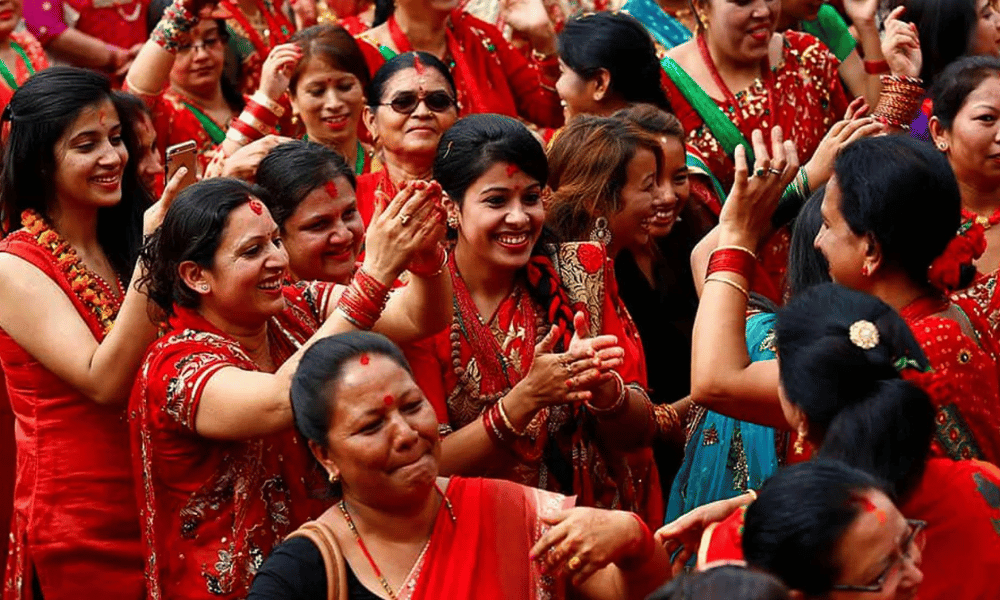
During Teej, the temple complex comes to life with the melodic sounds of joyful ladies dancing and singing old folk music. Married women come together on the temple grounds to perform rituals and offer prayers while wearing red saris and beautiful henna decorations on their hands. Women fast from food and water for the entire day, breaking their fast only after performing their evening prayers. It is a time for reflection and devotion.
At the Halesi Mahadev Temple, the Teej festival is a lively display of spirituality and culture. The ceremonies and rituals emphasize the close bond between Lord Shiva and Goddess Parvati, highlighting the value of marital harmony and the enduring power of the heavenly marriage. Everyone who attends the festivities will have a wonderful and spiritually enriching experience because of the environment, which resonates with dedication and the celebration of love.
Learn More: Teej Festival
Udhauli and Ubhauli Parva
Ubhauli and Udhauli are two important festivals celebrated at Halesi Mahadev Temple, reflecting the cultural diversity and spiritual significance of the region. These festivals are observed with great fervor by the local Kirat community and also draw the participation of people from various backgrounds.
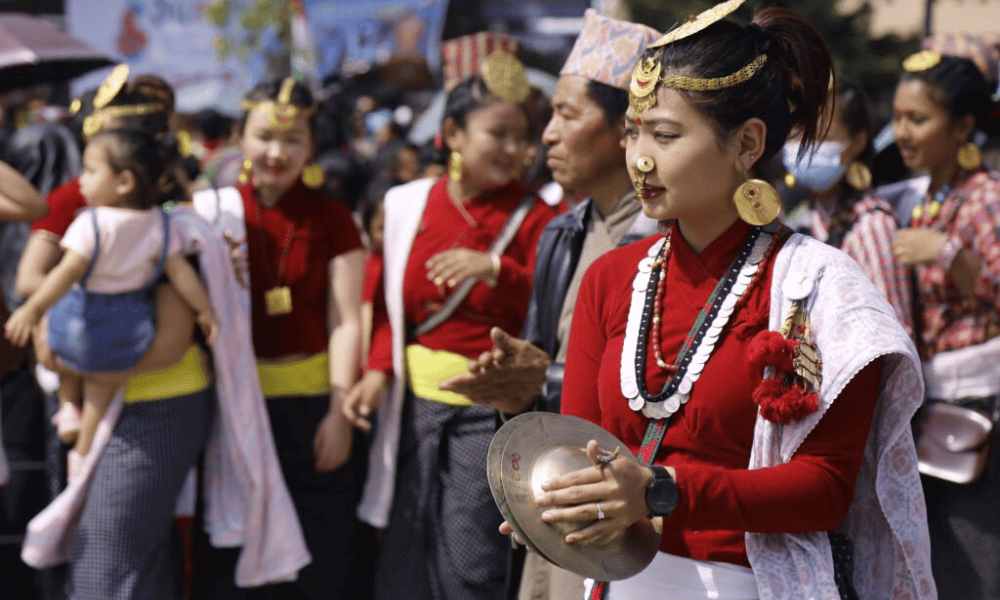
Ubhauli Festival
The Halesi region celebrates Ubhauli, which usually takes place in April or May, marking the start of the trekking season. It is a season of cultural celebrations and spiritual renewal. The Kirat community comes together at the Halesi Mahadev Temple during Ubhauli to make prayers and ask for blessings for the coming year. The banging of drums and other musical instruments is accompanied by the performance of traditional Kirat dance (Sakela) and rituals. The festival serves as both an opportunity to honor the temple's hallowed surroundings and a colorful celebration of nature and the passing of the seasons. Visitors and pilgrims are cordially invited to take part in the joyful Ubhauli celebrations and learn about the rich Kirat culture.
Udhauli Festival
On the other hand, Udhauli takes place in October or November and signifies the end of the trekking season as winter draws near. The Kirat people use this occasion to express gratitude for the crop and to ask for protection from the icy winter weather. Similar to Ubhauli, Halesi Mahadev Temple celebrates Udhauli with rituals, dances, and music. Devotees honor the natural splendor and spiritual value of the temple during this event. Udhauli is a crucial component of the region's religious and cultural calendar since it acts as a bridge between Kirat customs and the spiritual energy of the temple.
Both Ubhauli and Udhauli festivals at Halesi Mahadev Temple offer a unique opportunity for visitors to witness the vibrant Kirat culture and share in the spiritual and cultural heritage of this sacred site.
How to Reach
Reaching Halesi Mahadev Temple in Nepal requires careful planning and an understanding of the available transportation options. The temple is situated in the remote Khotang district of eastern Nepal, and the journey involves a combination of travel by flight, road and on foot.
From Kathmandu
By Private or Hired Vehicle:
Halesi Mahadev Temple is around 220 kilometers east of Kathmandu and takes 8 to 9 hours to reach. To get to Halesi Mahadev Temple by private or hired car, begin your journey in Kathmandu, Nepal. You can hire a private car or a jeep with a local driver to take you to Halesi from Kathmandu. The trip will be long and difficult on the road, so it's crucial to pick a dependable car and a knowledgeable driver who is familiar with the area.
You'll pass through rural areas and beautiful views during the drive. Be ready for a physically challenging trip since you'll be driving on twisty mountain roads and rocky terrain. Make sure your car is in good shape, that you have all the supplies you need, and that you have rest stops planned along the trip. Take stops as needed as the trip might be exhausting and gives you a chance to admire Nepal's scenic scenery.
By Public Bus:
Budget-conscious tourists can take one of the public buses that go from Kathmandu to the Khotang district, which is the area closest to the Halesi Mahadev Temple and is reachable by road. Bus travel is more affordable but might also take longer and be less pleasant than driving a private vehicle.
Start by traveling to Kathmandu's New Bus Park by local bus or taxi. After that, take a bus to Khotang. It's a good idea to check with the bus terminal for departure hours and ticket details as these buses do not operate on a set schedule. You'll go through winding roads and beautiful scenery on the bus, and you'll get the chance to talk to other passengers along the way who are locals.
Depending on the distance and the state of the roads when you reach Khotang, one might need to switch to smaller local vehicles or hike to the Halesi Mahadev Temple. Be ready for an adventure that might call for some flexibility and endurance.
By Air Travel (Helicopter and Plane):
For a faster and more convenient option, consider air travel to Halesi Mahadev Temple. There are two primary options: helicopter and plane.
Helicopter:
The quickest way to reach Halesi Mahadev Temple is to charter a helicopter. From Kathmandu, a helicopter flight to Halesi Mahadev can be arranged. This option significantly decreases travel time while offering breathtaking aerial views of Nepal's surroundings. Since a helicopter ride from Kathmandu to the Halesi Mahadev Temple and returning only takes two hours, one can visit the temple and return the same day.
Plane:
Another alternative is to fly from Kathmandu to Lamidanda Airport on a domestic flight. These flights are accessible, though the schedules might change. Depending on the precise location and road conditions, you may need to walk to the temple after reaching Lamidanda or continue traveling by car.
Air travel is the most efficient option but may be more expensive than land transportation. Ensure you book your flights in advance and check for any schedule changes or weather-related delays, as mountainous regions can experience unpredictable weather patterns.
Things to Remember
Before embarking on a journey to Halesi Mahadev Temple, it's crucial to prepare thoroughly to ensure a safe and spiritually fulfilling pilgrimage. Here are some essential things to remember
Dress Modestly: As with the majority of religious sites, it is recommended to wear modest clothing when visiting the temple. As a sign of respect, wear clothing that covers your shoulders and knees.
Photography and Video: Respect local customs and regulations regarding photography and videography. Always ask for permission before taking pictures of people or in sacred areas.
Local Etiquette: Familiarize yourself with local customs and etiquette. Show respect for sacred sites, local traditions, and the customs of the indigenous communities you may encounter.
Environment Conservation: Be a responsible traveler by disposing of trash properly and adhering to Leave No Trace principles. Preserve the natural beauty of the region.
Silence and Respect: While inside the temple, maintain a respectful and silent behavior. Refrain from loud conversation and disruptive conduct.
Conclusion
In conclusion, Nepal's Halesi Mahadev Temple is a strong symbol of spiritual devotion and cultural diversity. This sacred sanctuary, which is tucked away in the lush surroundings of the Khotang district, welcomes people of all faiths with open arms, including Buddhists, Hindus, and the native Kirat community. The temple's sacred grounds offer visitors a fascinating mix of cultural riches and natural wonders where faith and tradition come together to provide an unforgettable and enlightening experience.
Self-reflection and meditation are encouraged in the temple's mystical caves, such as Basaha Cave, while admiration and reverence are sparked by the site's natural wonders, such as the natural sankha and Lord Shiva's footprints. The spiritual tapestry of the temple complex is further enriched by the presence of Lord Ganesh, Lord Kartik, and Goddess Parvati symbols.
Festivals such as Maha Shivaratri, Ubhauli, and Udhauli infuse the Halesi Mahadev Temple with vibrant energy and cultural significance throughout the year. The fact that the earthly and the divine live together peacefully here shows Nepal's multi-faith and multicultural heritage. People from all walks of life come together to enjoy their beliefs, traditions, and spiritual ties.
Visitors and pilgrims leave this sacred site carrying not only Lord Shiva's blessings but also the unforgettable recollections of a journey that crosses boundaries and religions and is a place where Nepal's spiritual soul still thrives. With its lasting significance for Hindus, Buddhists, and the Kirat community, Halesi Mahadev Temple serves as a reminder that despite the difficulties we face in life, there is a place of refuge where religion, culture, and environment come together to provide comfort, inspiration, and a profound sense of unity.
Also Read: Pashupatinath Temple | Doleshwor Mahadev Temple

